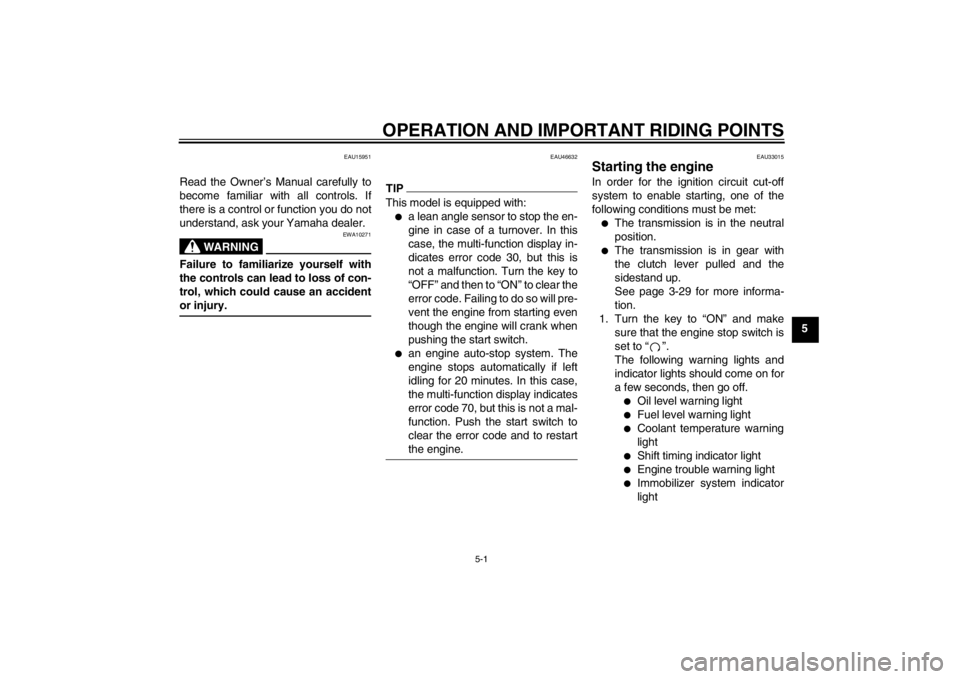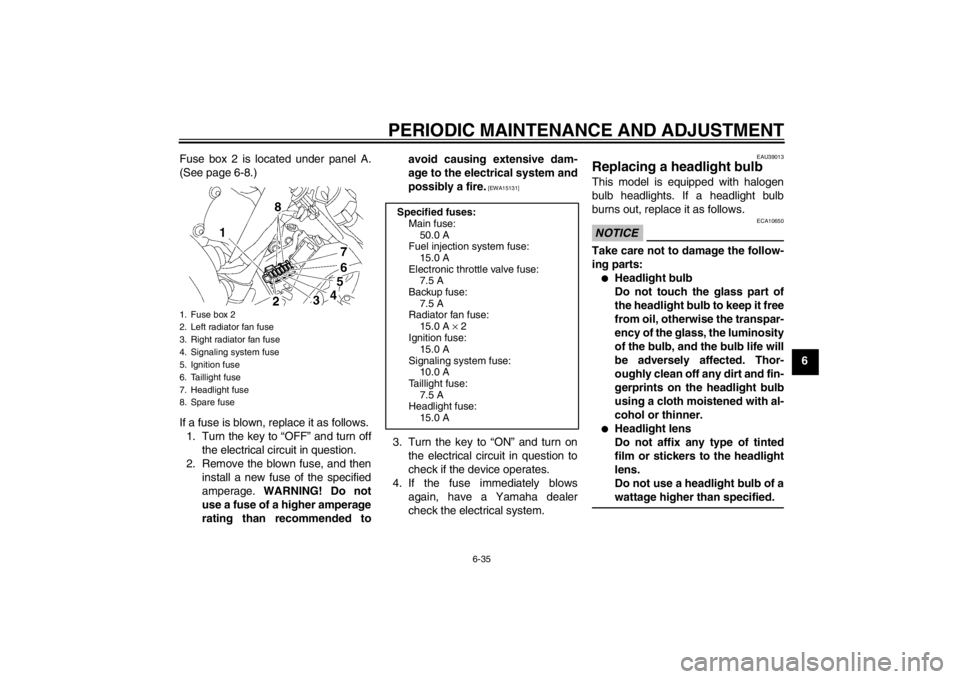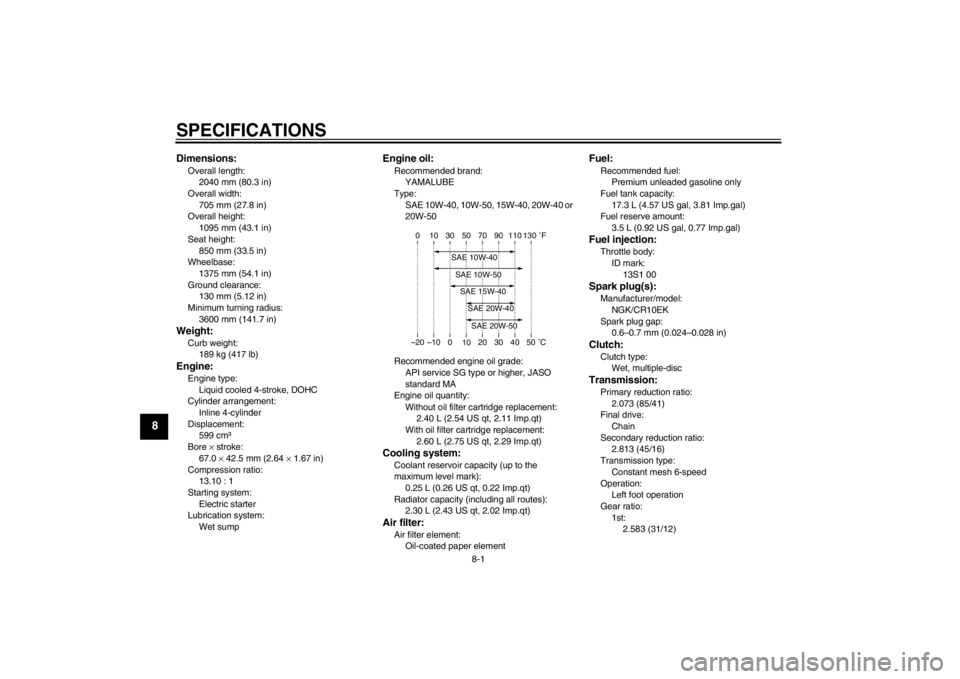ECO mode YAMAHA YZF-R6 2012 Owners Manual
[x] Cancel search | Manufacturer: YAMAHA, Model Year: 2012, Model line: YZF-R6, Model: YAMAHA YZF-R6 2012Pages: 112, PDF Size: 2.46 MB
Page 10 of 112

SAFETY INFORMATION
1-3
1
●
Do not run engine in poorly venti-
lated or partially enclosed areas
such as barns, garages, or car-
ports.
●
Do not run engine outdoors where
engine exhaust can be drawn into
a building through openings such
as windows and doors.
Loading
Adding accessories or cargo to your
motorcycle can adversely affect stabili-
ty and handling if the weight distribution
of the motorcycle is changed. To avoid
the possibility of an accident, use ex-
treme caution when adding cargo or
accessories to your motorcycle. Use
extra care when riding a motorcycle
that has added cargo or accessories.
Here, along with the information about
accessories below, are some general
guidelines to follow if loading cargo to
your motorcycle:
The total weight of the operator, pas-
senger, accessories and cargo must
not exceed the maximum load limit.
Operation of an overloaded vehicle
could cause an accident. When loading within this weight limit,
keep the following in mind:
●
Cargo and accessory weight
should be kept as low and close to
the motorcycle as possible. Se-
curely pack your heaviest items as
close to the center of the vehicle as
possible and make sure to distrib-
ute the weight as evenly as possi-
ble on both sides of the motorcycle
to minimize imbalance or instabili-
ty.
●
Shifting weights can create a sud-
den imbalance. Make sure that ac-
cessories and cargo are securely
attached to the motorcycle before
riding. Check accessory mounts
and cargo restraints frequently.
Properly adjust the suspension for your load (suspension-ad-
justable models only), and
check the condition and pres-
sure of your tires.
Never attach any large or heavy items to the handlebar, front
fork, or front fender. These items, including such cargo as
sleeping bags, duffel bags, or
tents, can create unstable han-
dling or a slow steering re-
sponse.
●
This vehicle is not designed to
pull a trailer or to be attached to
a sidecar.
Genuine Yamaha Accessories
Choosing accessories for your vehicle
is an important decision. Genuine
Yamaha accessories, which are avail- able only from a Yamaha dealer, have
been designed, tested, and approved
by Yamaha for use on your vehicle.
Many companies with no connection to
Yamaha manufacture parts and acces- sories or offer other modifications for
Yamaha vehicles. Yamaha is not in a position to test the products that these
aftermarket companies produce.
Therefore, Yamaha can neither en-
dorse nor recommend the use of ac-
cessories not sold by Yamaha or
modifications not specifically recom-
mended by Yamaha, even if sold and
installed by a Yamaha dealer.
Maximum load: 186 kg (410 lb)
U1JSE0E0.book Page 3 Wednesday, July 27, 2011 10:34 AM
Page 19 of 112

INSTRUMENT AND CONTROL FUNCTIONS
3-4
3
EAU49391
Indicator lights and warning
lights
EAU11030
Turn signal indicator lights “ ”
and “ ”
The corresponding indicator light flash-
es when the turn signal switch is
pushed to the left or right.
EAU11060
Neutral indicator light “ ”
This indicator light comes on when the
transmission is in the neutral position.
EAU11080
High beam indicator light “ ”
This indicator light comes on when the
high beam of the headlight is switched
on.
EAU11254
Oil level warning light “ ”
This warning light comes on if the en-
gine oil level is low.
The electrical circuit of the warning light
can be checked by turning the key to
“ON”. The warning light should come
on for a few seconds, and then go off.
If the warning light does not come on
initially when the key is turned to “ON”,
or if the warning light remains on, have
a Yamaha dealer check the electrical
circuit.TIP●
Even if the oil level is sufficient, the
warning light may flicker when
riding on a slope or during sudden
acceleration or deceleration, but
this is not a malfunction.
●
This model is also equipped with a
self-diagnosis device for the oil
level detection circuit. If a problem
is detected in the oil level detection
circuit, the following cycle will be
repeated until the malfunction is
corrected: The oil level warning
light will flash ten times, then go off
for 2.5 seconds. If this occurs,
have a Yamaha dealer check the
vehicle.
EAU11365
Fuel level warning light “ ”
This warning light comes on when the
fuel level drops below approximately
3.5 L (0.92 US gal, 0.77 Imp.gal). When
this occurs, refuel as soon as possible.
The electrical circuit of the warning light
can be checked by turning the key to
“ON”. The warning light should come
on for a few seconds, and then go off.
If the warning light does not come on
initially when the key is turned to “ON”,
or if the warning light remains on, have
a Yamaha dealer check the electrical
circuit.
1. Left turn signal indicator light “ ”
2. Neutral indicator light “ ”
3. High beam indicator light “ ”
4. Right turn signal indicator light “ ”
5. Fuel level warning light “ ”
6. Oil level warning light “ ”
7. Coolant temperature warning light “ ”
8. Shift timing indicator light
9. Engine trouble warning light “ ”
10.Immobilizer system indicator light
km/h
TRIP A
˚C
12 34 56
7
8
9
10
U1JSE0E0.book Page 4 Wednesday, July 27, 2011 10:34 AM
Page 20 of 112

INSTRUMENT AND CONTROL FUNCTIONS
3-5
3
TIPThis model is also equipped with a self-
diagnosis device for the fuel level de-
tection circuit. If a problem is detected
in the fuel level detection circuit, the fol-
lowing cycle will be repeated until the
malfunction is corrected: The fuel level
warning light will flash eight times, and
then go off for 3.0 seconds. If this oc-
curs, have a Yamaha dealer check the
vehicle.
EAU1142A
Coolant temperature warning
light “ ”
This warning light comes on if the en-
gine overheats. If this occurs, stop the
engine immediately and allow the en-
gine to cool.
The electrical circuit of the warning light
can be checked by turning the key to
“ON”. The warning light should come
on for a few seconds, and then go off.
If the warning light does not come on
initially when the key is turned to “ON”,
or if the warning light remains on, have
a Yamaha dealer check the electrical
circuit.
NOTICE
ECA10021
Do not continue to operate the en-
gine if it is overheating.TIP●
For radiator-fan-equipped vehi-
cles, the radiator fan(s) automati-
cally switch on or off according to
the coolant temperature in the ra-
diator.
●
If the engine overheats, see page
6-46 for further instructions.
U1JSE0E0.book Page 5 Wednesday, July 27, 2011 10:34 AM
Page 23 of 112

INSTRUMENT AND CONTROL FUNCTIONS
3-8
3
EAU39047
Multi-function meter unit
WARNING
EWA12422
Be sure to stop the vehicle before
making any setting changes to the
multi-function meter unit. Changing
settings while riding can distract the
operator and increase the risk of an
accident.
The multi-function meter unit is
equipped with the following:●
a speedometer
●
a tachometer
●
an odometer
●
two tripmeters (which show the
distance traveled since they were
last set to zero)
●
a fuel reserve tripmeter (which
shows the distance traveled since
the fuel level warning light came
on)
●
a stopwatch
●
a clock
●
a coolant temperature display
●
an air intake temperature display
●
a self-diagnosis device
●
a display brightness and shift tim-
ing indicator light control mode
TIP●
Be sure to turn the key to “ON” be-
fore using the “SELECT” and “RE-
SET” buttons, except for setting
the display brightness and shift
timing indicator light control mode.
●
For the U.K. only: To switch the
speedometer and odometer/trip-
meter displays between kilometers
and miles, press the “SELECT”
button for at least one second.
Tachometer
The electric tachometer allows the rider
to monitor the engine speed and keep it
within the ideal power range.
When the key is turned to “ON”, the ta-
chometer needle will sweep once
across the r/min range and then return
to zero r/min in order to test the electri-
cal circuit.
1. Speedometer
2. Clock
3. Tachometer
4. Coolant temperature display/air intake tem-perature display
5. Odometer/tripmeter/fuel reserve tripme- ter/stopwatch
6. Shift timing indicator light
7. “RESET” button
8. “SELECT” button
SELECT
RESET2
3
4
5
6
1
87
1. Tachometer
2. Tachometer red zone
2
1
U1JSE0E0.book Page 8 Wednesday, July 27, 2011 10:34 AM
Page 24 of 112

INSTRUMENT AND CONTROL FUNCTIONS
3-9
3
NOTICE
ECA10031
Do not operate the engine in the ta-
chometer red zone.
Red zone: 16500 r/min and aboveClock
To set the clock1. Turn the key to “ON”.
2. Push the “SELECT” button and“RESET” button together for at
least two seconds.
3. When the hour digits start flashing, push the “RESET” button to set the
hours.
4. Push the “SELECT” button, and the minute digits will start flashing. 5. Push the “RESET” button to set
the minutes.
6. Push the “SELECT” button and then release it to start the clock.
Odometer, tripmeter, and stopwatch
modes
Push the “SELECT” button to switch
the display between the odometer
mode “ODO”, the tripmeter modes
“TRIP A” and “TRIP B” and the stop-
watch mode in the following order:
TRIP A → TRIP B → ODO → Stop-
watch → TRIP A
If the fuel level warning light comes on
(see page 3-4), the odometer display
will automatically change to the fuel re- serve tripmeter mode “F-TRIP” and
start counting the distance traveled
from that point. In that case, push the
“SELECT” button to switch the display
between the various tripmeter, odome-
ter, and stopwatch modes in the follow-
ing order:
F-TRIP
→ Stopwatch → TRIP A →
TRIP B → ODO → F-TRIP
To reset a tripmeter, select it by push-
ing the “SELECT” button, and then
push the “RESET” button for at least
one second. If you do not reset the fuel
reserve tripmeter manually, it will reset
itself automatically and the display will
return to the prior mode after refueling
and traveling 5 km (3 mi).
Stopwatch mode
To change the display to the stopwatch
mode, select it by pushing the “SE-
LECT” button. (The stopwatch digits
will start flashing.) Release the “SE-
LECT” button, and then push it again
for a few seconds until the stopwatch
digits stop flashing.1. Clock
km/h
TRIP A
1
1. Odometer/tripmeter/fuel reserve tripme- ter/stopwatch
TRIP A
˚C
1
U1JSE0E0.book Page 9 Wednesday, July 27, 2011 10:34 AM
Page 25 of 112

INSTRUMENT AND CONTROL FUNCTIONS
3-10
3
Standard measurement
1. Push the “RESET” button to start
the stopwatch.
2. Push the “SELECT” button to stop the stopwatch.
3. Push the “SELECT” button again to reset the stopwatch.
Split-time measurement1. Push the “RESET” button to start the stopwatch.
2. Push the “RESET” button or start switch “ ” to measure split-times.
(The colon “:” will start flashing.)
3. Push the “RESET” button or start switch “ ” to display the final split-
time or push the “SELECT” button
to stop the stopwatch and display
total elapsed time.
4. Push the “SELECT” button to reset the stopwatch.TIPTo change the display back to the prior
mode, push the “SELECT” button for a
few seconds until the stopwatch digits
flash.
Coolant temperature display
The coolant temperature display indi-
cates the temperature of the coolant.TIPWhen the coolant temperature display
is selected, “C” is displayed for one
second, and then the coolant tempera-
ture is displayed.NOTICE
ECA10021
Do not continue to operate the en-
gine if it is overheating.
Air intake temperature display
The air intake temperature display indi-
cates the temperature of the air drawn
into the air intake duct. Push the “RE-
SET” button to switch the coolant tem-
perature display to the air intake
temperature display.TIP●
Even if the air intake temperature
is set to be displayed, the coolant
temperature warning light comes
on if the engine overheats.
●
When the key is turned to “ON”,
the coolant temperature is auto-
matically displayed, even if the air
intake temperature was displayed
prior to turning the key to “OFF”.
1. Coolant temperature display
TRIP A
˚C
1
1. Air intake temperature display
TRIP A
˚C
1
U1JSE0E0.book Page 10 Wednesday, July 27, 2011 10:34 AM
Page 27 of 112

INSTRUMENT AND CONTROL FUNCTIONS
3-12
3
This mode cycles through five control
functions, allowing you to make the fol-
lowing settings in the order listed be-
low.
●
Display brightness:
This function allows you to adjust
the brightness of the displays and
tachometer to suit the outside
lighting conditions.
●
Shift timing indicator light activity:
This function allows you to choose
whether or not the indicator light
should be activated and whether it
should flash or stay on when acti-
vated.
●
Shift timing indicator light activa-
tion:
This function allows you to select
the engine speed at which the indi-
cator light will be activated.
●
Shift timing indicator light deactiva-
tion:
This function allows you to select
the engine speed at which the indi-
cator light will be deactivated.
●
Shift timing indicator light bright-
ness:
This function allows you to adjust
the brightness of the indicator light
to suit your preference.
TIPIn this mode, the right display shows
the current setting for each function
(except the shift timing indicator light
activity function).To adjust the brightness of the multi-function meter displays and tachometer1. Turn the key to “OFF”.
2. Push and hold the “SELECT” but-
ton.
3. Turn the key to “ON”, and then re- lease the “SELECT” button after
five seconds.
4. Push the “RESET” button to select the desired brightness level.
5. Push the “SELECT” button to con- firm the selected brightness level.
The control mode changes to the
shift timing indicator light activity
function. To set the shift timing indicator light ac-
tivity function1. Push the “RESET” button to select
one of the following indicator light
activity settings:
●
The indicator light will stay on
when activated. (This setting
is selected when the indicator
light stays on.)
●
The indicator light will flash
when activated. (This setting
is selected when the indicator
light flashes four times per
second.)
●
The indicator light is deacti-
vated; in other words, it will
not come on or flash. (This
setting is selected when the
indicator light flashes once
every two seconds.)
2. Push the “SELECT” button to con- firm the selected indicator light ac-
tivity. The control mode changes to
the shift timing indicator light acti-
vation function.
U1JSE0E0.book Page 12 Wednesday, July 27, 2011 10:34 AM
Page 49 of 112

OPERATION AND IMPORTANT RIDING POINTS
5-1
5
EAU15951
Read the Owner’s Manual carefully to
become familiar with all controls. If
there is a control or function you do not
understand, ask your Yamaha dealer.
WARNING
EWA10271
Failure to familiarize yourself with
the controls can lead to loss of con-
trol, which could cause an accident
or injury.
EAU46632
TIPThis model is equipped with:●
a lean angle sensor to stop the en-
gine in case of a turnover. In this
case, the multi-function display in-
dicates error code 30, but this is
not a malfunction. Turn the key to
“OFF” and then to “ON” to clear the
error code. Failing to do so will pre-
vent the engine from starting even
though the engine will crank when
pushing the start switch.
●
an engine auto-stop system. The
engine stops automatically if left
idling for 20 minutes. In this case,
the multi-function display indicates
error code 70, but this is not a mal-
function. Push the start switch to
clear the error code and to restart
the engine.
EAU33015
Starting the engine In order for the ignition circuit cut-off
system to enable starting, one of the
following conditions must be met:●
The transmission is in the neutral
position.
●
The transmission is in gear with
the clutch lever pulled and the
sidestand up.
See page 3-29 for more informa-
tion.
1. Turn the key to “ON” and make sure that the engine stop switch is
set to “ ”.
The following warning lights and
indicator lights should come on for
a few seconds, then go off.●
Oil level warning light
●
Fuel level warning light
●
Coolant temperature warning
light
●
Shift timing indicator light
●
Engine trouble warning light
●
Immobilizer system indicator
light
U1JSE0E0.book Page 1 Wednesday, July 27, 2011 10:34 AM
Page 87 of 112

PERIODIC MAINTENANCE AND ADJUSTMENT
6-35
6
Fuse box 2 is located under panel A.
(See page 6-8.)
If a fuse is blown, replace it as follows.
1. Turn the key to “OFF” and turn off the electrical circuit in question.
2. Remove the blown fuse, and then install a new fuse of the specified
amperage. WARNING! Do not
use a fuse of a higher amperage
rating than recommended to avoid causing extensive dam-
age to the electrical system and
possibly a fire.
[EWA15131]
3. Turn the key to “ON” and turn on
the electrical circuit in question to
check if the device operates.
4. If the fuse immediately blows again, have a Yamaha dealer
check the electrical system.
EAU39013
Replacing a he adlight bulb This model is equipped with halogen
bulb headlights. If a headlight bulb
burns out, replace it as follows.NOTICE
ECA10650
Take care not to damage the follow-
ing parts:●
Headlight bulb
Do not touch the glass part of
the headlight bulb to keep it free
from oil, otherwise the transpar-
ency of the glass, the luminosity
of the bulb, and the bulb life will
be adversely affected. Thor-
oughly clean off any dirt and fin-
gerprints on the headlight bulb
using a cloth moistened with al-
cohol or thinner.
●
Headlight lens
Do not affix any type of tinted
film or stickers to the headlight
lens.
Do not use a headlight bulb of a
wattage higher than specified.
1. Fuse box 2
2. Left radiator fan fuse
3. Right radiator fan fuse
4. Signaling system fuse
5. Ignition fuse
6. Taillight fuse
7. Headlight fuse
8. Spare fuse
Specified fuses:
Main fuse:50.0 A
Fuel injection system fuse:
15.0 A
Electronic throttle valve fuse: 7.5 A
Backup fuse: 7.5 A
Radiator fan fuse:
15.0 A × 2
Ignition fuse: 15.0 A
Signaling system fuse: 10.0 A
Taillight fuse:
7.5 A
Headlight fuse: 15.0 A
U1JSE0E0.book Page 35 Wednesday, July 27, 2011 10:34 AM
Page 104 of 112

SPECIFICATIONS
8-1
8
Dimensions:Overall length:2040 mm (80.3 in)
Overall width:
705 mm (27.8 in)
Overall height: 1095 mm (43.1 in)
Seat height: 850 mm (33.5 in)
Wheelbase:
1375 mm (54.1 in)
Ground clearance: 130 mm (5.12 in)
Minimum turning radius: 3600 mm (141.7 in)Weight:Curb weight:189 kg (417 lb)Engine:Engine type:
Liquid cooled 4-stroke, DOHC
Cylinder arrangement: Inline 4-cylinder
Displacement: 599 cm³
Bore × stroke:
67.0 × 42.5 mm (2.64 × 1.67 in)
Compression ratio: 13.10 : 1
Starting system: Electric starter
Lubrication system:
Wet sump
Engine oil:Recommended brand:YAMALUBE
Type:
SAE 10W-40, 10W-50, 15W-40, 20W-40 or
20W-50
Recommended engine oil grade: API service SG type or higher, JASO
standard MA
Engine oil quantity:
Without oil filter cartridge replacement: 2.40 L (2.54 US qt, 2.11 Imp.qt)
With oil filter cartridge replacement:
2.60 L (2.75 US qt, 2.29 Imp.qt)Cooling system:Coolant reservoir capacity (up to the
maximum level mark):0.25 L (0.26 US qt, 0.22 Imp.qt)
Radiator capacity (including all routes): 2.30 L (2.43 US qt, 2.02 Imp.qt)Air filter:Air filter element:Oil-coated paper element
Fuel:Recommended fuel:Premium unleaded gasoline only
Fuel tank capacity:
17.3 L (4.57 US gal, 3.81 Imp.gal)
Fuel reserve amount: 3.5 L (0.92 US gal, 0.77 Imp.gal)Fuel injection:Throttle body:
ID mark: 13S1 00Spark plug(s):Manufacturer/model:NGK/CR10EK
Spark plug gap: 0.6–0.7 mm (0.024–0.028 in)Clutch:Clutch type:Wet, multiple-discTransmission:Primary reduction ratio:
2.073 (85/41)
Final drive: Chain
Secondary reduction ratio: 2.813 (45/16)
Transmission type:
Constant mesh 6-speed
Operation: Left foot operation
Gear ratio: 1st: 2.583 (31/12)
–20 –10 0 1020 30 40 50 �C
10 30 50 70 90 110
0 130 �F
SAE 20W-50SAE 20W-40SAE 15W-40SAE 10W-40SAE 10W-50
U1JSE0E0.book Page 1 Wednesday, July 27, 2011 10:34 AM